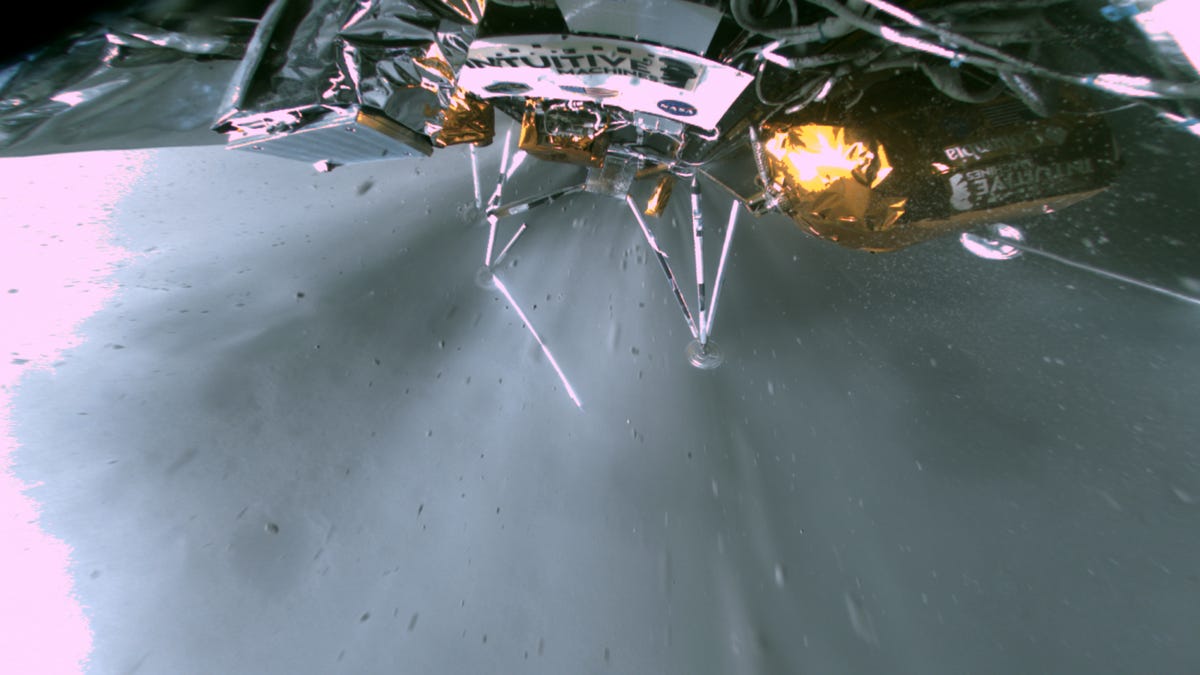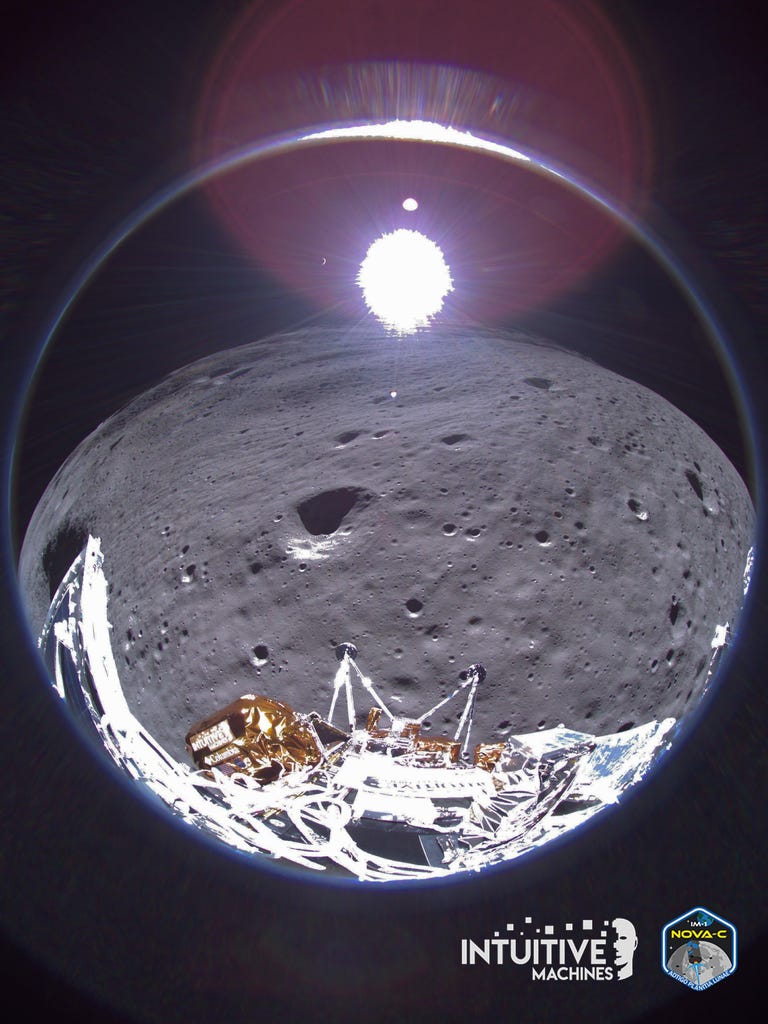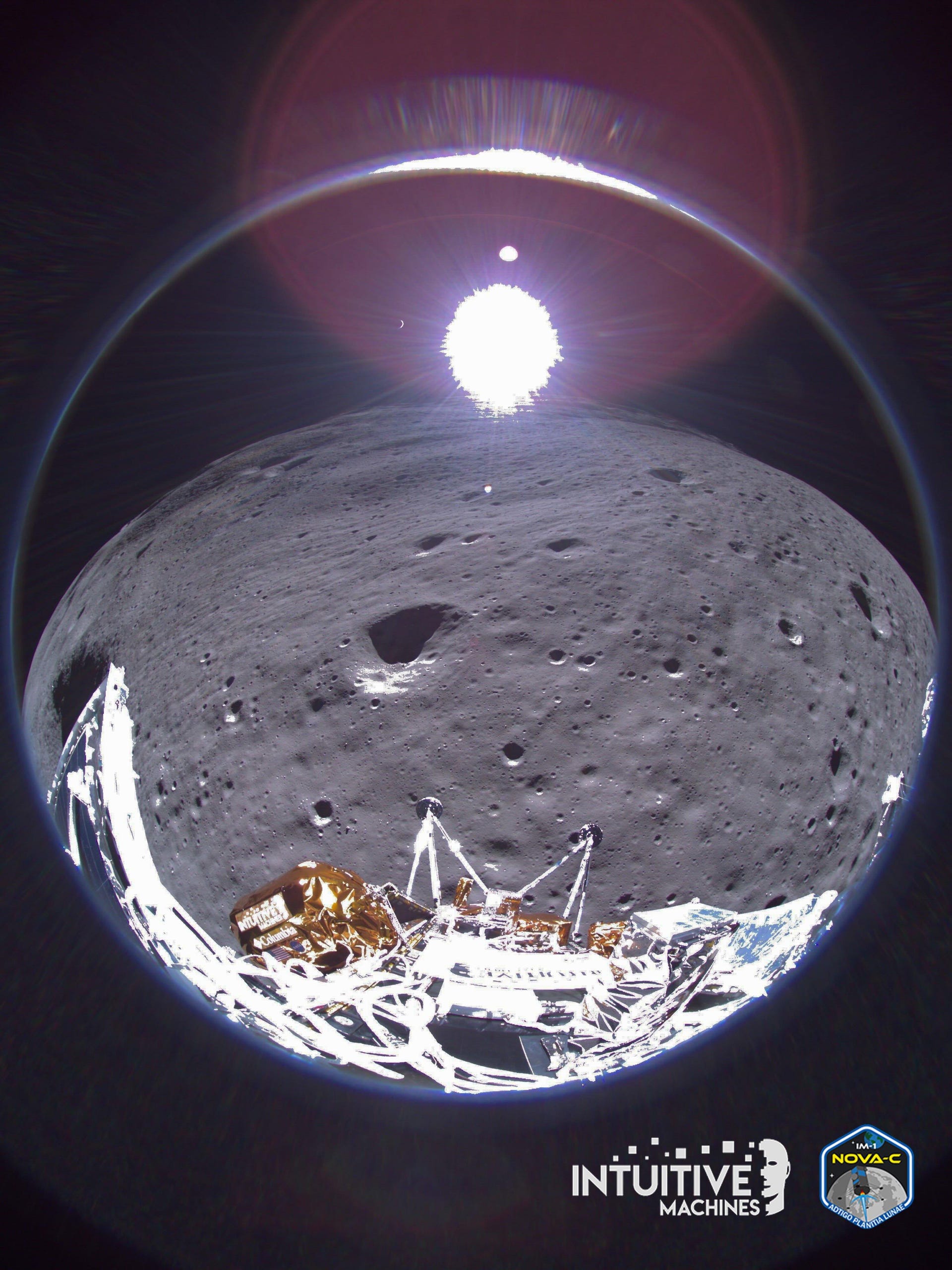Technologies
Odysseus Lunar Lander Sent a Farewell Photo of Earth: Now What?
All about the first US moon mission in more than 50 years. No astronauts, but this effort will help them return.

Goodbye, Odie. On Thursday, Houston-based space-exploration company Intuitive Machines bade farewell to Odysseus, the lunar lander that took the US to the moon for the first time in more than 50 years. The lander had been there for a week and will remain on the moon’s surface, inoperable but remembered as a historic achievement in the annals of lunar exploration.
«Before its power was depleted, Odysseus completed a fitting farewell transmission,» the company wrote in a tweet shared on Thursday. «Received today, this image from February 22nd showcases the crescent Earth in the backdrop, a subtle reminder of humanity’s presence in the universe. Goodnight, Odie. We hope to hear from you.»


Intuitive Machines successfully landed Odysseus on the moon’s surface Feb. 22, after a seven-day space trek by the craft. It’s the first time an American vehicle has been on the surface of the moon since Apollo 17 in 1972. But unlike the Apollo missions, which were entirely operated by NASA, this time the space agency hired the private company to send a lander to the moon.
The United States is the only country to ever put humans on the moon, but its focus shifted away from the lunar surface in the 1970s. In recent years, though, NASA has been planning a return, through its Artemis mission, which right now is scheduled to put boots back on the moon no earlier than September 2026 (several years after the original target date). Meanwhile, the space agency has been working with private companies like Elon Musk’s SpaceX and Jeff Bezos’ Blue Horizon on a variety of missions, including through its Commercial Lunar Payload Services initiative. The Odysseus mission was under CLPS auspices.
Here’s what to know.

Odysseus moon mission
The Odysseus mission was endorsed by NASA to collect scientific data from the moon’s surface. The lander, known internally as the Nova-C lander — and fondly to Intuitive employees as «Odie» — is about the size of a phone booth. It landed in the South Pole region of the moon called Malapert A at 6:24 p.m. ET on Feb. 22.
Odie was equipped with a host of instruments to investigate the lunar surface and radio waves and send photos back to the US, NASA said. The lander also featured a retroflector array that helped NASA identify its location and keep track of where to send other autonomous vehicles during future missions.
The launch and landing part of the mission lasted seven days, but it was fraught with drama after the Intuitive Machines team discovered that the lander’s range-finding system was inoperable and that the team needed to recode Odysseus to use a different range-finding system to pull off a safe landing. What’s worse, the team found that Odysseus was descending at a rate much faster than expected, increasing the likelihood of a crash. Luckily, that didn’t happen.
What to know about Intuitive Machines
Intuitive Machines is the first benefactor of the NASA Commercial Lunar Payload Services program, which the agency started in 2018. NASA researched whether to build and send a lunar lander of its own to the moon. But the space agency determined it would be cheaper, with potentially greater chances of success, to instead pay commercial companies to handle the task.
NASA paid Intuitive Machines $118 million to send Odysseus to the moon. The agency hoped to learn more about the lunar surface and where to eventually send humans back to the moon.
About the Odysseus technology
Odysseus carried several instruments for learning more about the moon and space.
En route to the moon, NASA instruments aboard the craft measured its consumption of cryogenic fuel, and while Odysseus was touching down, another instrument tested the dust the lander kicked up.
Once Odysseus was on the moon, additional technologies were used to evaluate the lunar surface. One, called the Lunar Node 1 Demonstrator, focused on autonomous navigation to show how future landers could traverse the surface. A Laser Retroflector Array conducted range-finding and distance measurements. And a radio wave instrument analyzed the moon’s surface radio waves to determine how’d they’d affect the work of humans conducting science there. Also, four cameras captured images of the lander’s environment.
Tipsy Odysseus
Intuitive Machines confirmed that Odysseus landed off-kilter after it apparently got one of its feet caught on something. The company now believes the lander is either tilted on a rock or lying on its side on the slope of a hill.
Despite the less-than-ideal positioning, Intuitive Machines was able to communicate with Odysseus and its sensors remained operational.
Short life span
Though Odysseus spent just a week on the lunar surface, that’s all it gets. The lander was slated to be operational for only nine to 10 days. After that, Intuitive Machines knew the sun would set on the landing site, and Odysseus’ radios and batteries can’t survive the extremely cold lunar nights.
What’s next
The Odysseus lander mission is just the first in a string of NASA missions that aim at eventually getting astronauts back to the moon. Like Odysseus, future landers will explore the lunar surface, scout ideal locations for landing astronauts, and perform scientific research.
For its part, Intuitive Machines isn’t done on the moon. The Odysseus mission may be over, but the company is already working on two other moon lander missions, slated to launch later this year.
Technologies
How to Get Verizon’s New Internet Plan for Just $25 Per Month
Technologies
This $20K Humanoid Robot Promises to Tidy Your Home. But There Are Strings Attached
The new Neo robot from 1X is designed to do chores. It’ll need help from you — and from folks behind the curtain.

It stands 5 feet, 6 inches tall, weighs about as much as a golden retriever and costs near the price of a brand-new budget car.
This is Neo, the humanoid robot. It’s billed as a personal assistant you can talk to and eventually rely on to take care of everyday tasks, such as loading the dishwasher and folding laundry.
Neo doesn’t work cheap. It’ll cost you $20,000. And even then, you’ll still have to train this new home bot, and possibly need a remote assist as well.
If that sounds enticing, preorders are now open (for a mere $200 down). You’ll be signing up as an early adopter for what Neo’s maker, a California-based company called 1X, is calling a «consumer-ready humanoid.» That’s opposed to other humanoids under development from the likes of Tesla and Figure, which are, for the moment at least, more focused on factory environments.
Neo is a whole order of magnitude different from robot vacuums like those from Roomba, Eufy and Ecovacs, and embodies a long-running sci-fi fantasy of robot maids and butlers doing chores and picking up after us. If this is the future, read on for more of what’s in store.
Don’t miss any of our unbiased tech content and lab-based reviews. Add CNET as a preferred Google source.
What the Neo robot can do around the house
The pitch from 1X is that Neo can do all manner of household chores: fold laundry, run a vacuum, tidy shelves, bring in the groceries. It can open doors, climb stairs and even act as a home entertainment system.
Neo appears to move smoothly, with a soft, almost human-like gait, thanks to 1X’s tendon-driven motor system that gives it gentle motion and impressive strength. The company says it can lift up to 154 pounds and carry 55 pounds, but it is quieter than a refrigerator. It’s covered in soft materials and neutral colors, making it look less intimidating than metallic prototypes from other companies.
The company says Neo has a 4-hour runtime. Its hands are IP68-rated, meaning they’re submersible in water. It can connect via Wi-Fi, Bluetooth and 5G. For conversation, it has a built-in LLM, the same sort of AI technology that powers ChatGPT and Gemini.
The primary way to control the Neo robot will be by speaking to it, just as if it were a person in your home.
Still, Neo’s usefulness today depends heavily on how you define useful. The Wall Street Journal’s Joanna Stern got an up-close look at Neo at 1X’s headquarters and found that, at least for now, it’s largely teleoperated, meaning a human often operates it remotely using a virtual-reality headset and controllers.
«I didn’t see Neo do anything autonomously, although the company did share a video of Neo opening a door on its own,» Stern wrote last week.
1X CEO Bernt Børnich told her that Neo will do most things autonomously in 2026, though he also acknowledged that the quality «may lag at first.»
The company’s FAQ says that for any chore request Neo doesn’t know how to accomplish, «you can schedule a 1X Expert to guide it» to help the robot «learn while getting the job done.»
What you need to know about Neo and privacy
Part of what early adopters are signing up for is to let Neo learn from their environment so that future versions can operate more independently.
That learning process raises privacy and trust questions. The robot uses a mix of visual, audio and contextual intelligence — meaning it can see, hear and remember interactions with users throughout their homes.
«If you buy this product, it is because you’re OK with that social contract,» Børnich told the Journal. «It’s less about Neo instantly doing your chores and more about you helping Neo learn to do them safely and effectively.»
Neo’s reliance on human operation behind the scenes prompted a response from John Carmack, a computer industry luminary known for his work with VR systems and the lead programmer of classic video games including Doom and Quake.
«Companies selling the dream of autonomous household humanoid robots today would be better off embracing reality and selling ‘remote operated household help’,» he wrote in a post on the X social network (formerly Twitter) on Monday.
1X says it’s taking steps to protect your privacy: Neo listens only when it recognizes it’s being addressed, and its cameras will blur out humans. You can restrict Neo from entering or viewing specific areas of your home, and the robot will never be teleoperated without owner approval, the company says.
But inviting an AI-equipped humanoid to observe your home life isn’t a small step.
The first units will ship to customers in the US in 2026. There is a $499 monthly subscription alternative to the $20,000 full-purchase price, though that will be available at an unspecified later date. A broader international rollout is promised for 2027.
Neo’s got a long road ahead of it to live up to the expectations set by Rosie the Robot in The Jetsons way back when. But this is no Hanna-Barbera cartoon. What we’re seeing now is a much more tangible harbinger of change.
Technologies
I Wish Nintendo’s New Switch 2 Zelda Game Was an Actual Zelda Game
Hyrule Warriors: Age of Imprisonment has great graphics, a great story and Zelda is actually in it. But the gameplay makes me wish for another true Zelda title instead.

I’ve never been a Hyrule Warriors fan. Keep that in mind when I say that Nintendo’s new Switch 2-exclusive Zelda-universe game has impressed me in several ways, but the gameplay isn’t one of them. Still, this Zelda spinoff has succeeded in showing off the Switch 2’s graphics power. Now can we have a true Switch 2 exclusive Zelda game next?
The upgraded graphics in Tears of the Kingdom and Breath of the Wild has made the Switch 2 a great way to play recent Zelda games, which had stretched the Switch’s capabilities to the limit before. And they’re both well worth revisiting, because they’re engrossing, enchanting, weird, epic wonders. Hyrule Warriors: Age of Imprisonment, another in the Koei-Tecmo developed spinoff series of Zelda-themed games, is a prequel to Tears of the Kingdom. It’s the story of Zelda traveling back in time to ancient Hyrule, and the origins of Ganondorf’s evil. I’m here for that, but a lot of hack and slash battles are in my way.
A handful of hours in, I can say that the production values are wonderful. The voices and characters and worlds feel authentically Zelda. I feel like I’m getting a new chapter in the story I’d already been following. The Switch 2’s graphics show off smooth animation, too, even when battles can span hundreds of enemies.
But the game’s central style, which is endless slashing fights through hordes of enemies, gets boring for me. That’s what Hyrule Warriors is about, but the game so far feels more repetitive than strategic. And I just keep button-mashing to get to the next story chapter. For anyone who’s played Hyrule Warriors: Age of Calamity, expect more of the same, for the most part.
I do like that the big map includes parts in the depths and in the sky, mirroring the tri-level appeal of Tears of the Kingdom. But Age of Calamity isn’t a free-wandering game. Missions open up around the map, each one opening a contained map to battle through. Along the way, you unlock an impressive roster of Hyrule characters you can control.
As a Switch 2 exclusive to tempt Nintendo fans to make the console upgrade, it feels like a half success. I admire the production values, and I want to keep playing just to see where the story goes. But as a purchase, it’s a distant third to Donkey Kong Bananza and Mario Kart World.
Hyrule Warriors fans, you probably know what you’re probably in for, and will likely get this game regardless. Serious Zelda fans, you may enjoy it just for the story elements alone.
As for me? I think I’ll play some more, but I’m already sort of tuning the game out a bit. I want more exploration, more puzzles, more curiosity. This game’s not about that. But it does show me how good a true next-gen Zelda could be on the Switch 2, whenever Nintendo decides to make that happen.
-

 Technologies3 года ago
Technologies3 года agoTech Companies Need to Be Held Accountable for Security, Experts Say
-

 Technologies3 года ago
Technologies3 года agoBest Handheld Game Console in 2023
-

 Technologies3 года ago
Technologies3 года agoTighten Up Your VR Game With the Best Head Straps for Quest 2
-

 Technologies4 года ago
Technologies4 года agoVerum, Wickr and Threema: next generation secured messengers
-

 Technologies4 года ago
Technologies4 года agoBlack Friday 2021: The best deals on TVs, headphones, kitchenware, and more
-

 Technologies4 года ago
Technologies4 года agoGoogle to require vaccinations as Silicon Valley rethinks return-to-office policies
-

 Technologies4 года ago
Technologies4 года agoOlivia Harlan Dekker for Verum Messenger
-

 Technologies4 года ago
Technologies4 года agoiPhone 13 event: How to watch Apple’s big announcement tomorrow
